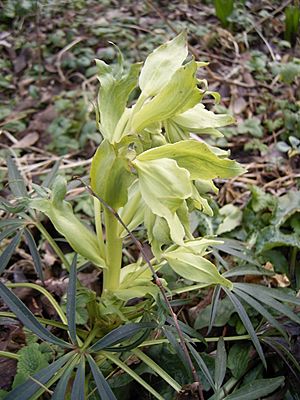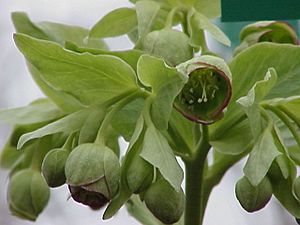Helleborus foetidus facts for kids
Quick facts for kids Helleborus foetidus |
|
|---|---|
 |
|
| Scientific classification | |
| Genus: |
Helleborus
|
| Species: |
foetidus
|
Helleborus foetidus, also called stinking hellebore, dungwort, setterwort, or bear's foot, is a type of flowering plant. It belongs to the buttercup family, called Ranunculaceae. This plant naturally grows in the mountains of Central and Southern Europe and Asia Minor. You can also find it growing wild in many parts of England, especially where the soil has lots of limestone.
Contents
About the Stinking Hellebore Plant
The stinking hellebore is an evergreen plant. This means it stays green all year and lives for more than two years. It can grow up to 80 centimeters (about 31 inches) tall and 100 centimeters (about 39 inches) wide. It has a thick, juicy stem and shiny leaves.
Flowers and Their Features
Its drooping, cup-shaped flowers appear in spring. They are usually yellowish-green. Often, they have a purple edge on their five petal-like parts, called sepals. These flowers grow on strong, upright stems.
Like other plants in its family, the flowers have many stamens. These are the parts that produce pollen. They also have up to ten nectaries. Nectaries are small parts that make sweet nectar. This nectar attracts bees and other insects. Each flower then produces up to five (usually three) wrinkled seed pods, called follicles.
Why Is It Called "Stinking"?
Even though its common name is "stinking hellebore," the plant does not smell bad most of the time. However, if you crush its leaves, they do have a strong smell.
Important Safety Information
It's very important to know that all parts of the stinking hellebore plant are poisonous. They contain special chemicals called glycosides. If someone were to eat parts of the plant, it could cause severe stomach upset and confusion. So, it's best to admire this plant without touching or tasting it.
How Flowers Stay Warm
Scientists have found something interesting about this plant. Tiny yeasts live inside the nectaries of the stinking hellebore flowers. When these yeasts are present, they make the flower warmer. This warmth might help the flower attract more pollinators. It does this by making the plant's natural scents evaporate more easily. The stinking hellebore was the first plant where scientists discovered this warming effect.
Growing Stinking Hellebore in Gardens
Gardeners often grow H. foetidus because of its attractive evergreen leaves. They also like its many green, bell-shaped flowers that bloom in late winter.
Best Growing Conditions
This plant likes conditions similar to a woodland. It prefers soil that is deep, rich, moist, and drains well. The soil should also have lots of humus, which is decayed plant material. It grows best in dappled shade, where it gets some sunlight but not too much direct sun. Even though it likes moisture, this plant can also handle dry periods. You often find it growing naturally on chalk or limestone soils.
Awards and Special Types
The Royal Horticultural Society has given this plant its Award of Garden Merit. This award means it is an excellent plant for gardens.
There are also different types of stinking hellebore:
- Green Giant: This type has very bright green flowers and leaves that are finely divided.
- Miss Jekyll: Its flowers have a nice smell, but how strong the smell is can change throughout the day.
- Wester Flisk Group: This group has leaves and stems that are tinted red, and its flowers are gray-green.
- Sierra Nevada Group: This is a smaller type that only grows to about 30 centimeters (12 inches) tall.
How the Plant Spreads
You can grow new stinking hellebore plants in two ways. You can divide an existing plant, or you can grow them from seeds. The seeds can spread very well in good conditions, helping the plant grow naturally in new areas. However, it's important to keep rodents away from the garden. Rodents like to eat the seeds, either while they are still on the plant or after they have fallen to the ground.
See also
 In Spanish: Eléboro fétido para niños
In Spanish: Eléboro fétido para niños



